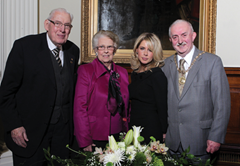High Sheriff’s ceremonial role
 Around 1,000 years ago a High Sheriff ran the military and looked after tax collection but the role is now much more honorary. Emma Blee writes.
Around 1,000 years ago a High Sheriff ran the military and looked after tax collection but the role is now much more honorary. Emma Blee writes.
The office of High Sheriff is the oldest secular office in the UK and has existed for more than 1,000 years but its powers have changed significantly.
The Local Government (Ireland) Act 1898 allowed for the appointment of High Sheriffs in Northern Ireland. In 1900 Sir James Henderson was the first to take on the position in the newly created County Borough of the City of Belfast, followed by Otto Jaffe in 1901.
There are eight sheriffs in Northern Ireland; one for each county, and one for each county borough, i.e. the cities of Derry and Belfast.
Here, the appointment is officially made by the Secretary of State on behalf of the Queen. An outgoing High Sheriff nominates their successor, except in Belfast where councillors put forward a nominee, who is always a serving member.
The incoming High Sheriff is then officially notified by letter and is sent a warrant of appointment signed by the Secretary of State and a ‘declaration of sheriff’, which has to be sworn before a Commissioner of Oaths at an official ceremony.
In England, hopefuls are also nominated by the current title holder, who passes a list of suitable candidates to a special tribunal. The list is then shown to the Queen, who picks the name by ‘pricking’ the list with a sharp needle, or bodkin.
In the 10th century, the ‘shire reeves’ or sheriffs, acted on behalf of the King as local government officials and held powers such as running the military and tax collection. The High Sheriffs also had law enforcement powers and could raise the “hue and cry” if there were felons within their shire.
However, when the Grand Jury was abolished in 1969, the role became much The incoming High Sheriff is then officially notified by letter and is sent a warrant of appointment signed by the Secretary of State and a ‘declaration of sheriff’, which has to be sworn before a Commissioner of Oaths at an official ceremony.
In England, hopefuls are also nominated by the current title holder, who passes a list of suitable candidates to a special tribunal. The list is then shown to the Queen, who picks the name by ‘pricking’ the list with a sharp needle, or bodkin.
In the 10th century, the ‘shire reeves’ or sheriffs, acted on behalf of the King as local government officials and held powers such as running the military and tax collection. The High Sheriffs also had law enforcement powers and could raise the “hue and cry” if there were felons within their shire.
However, when the Grand Jury was abolished in 1969, the role became much more honorary. A High Sheriff’s main responsibility is to attend any royal visits that take place within their specific area. In Belfast, the High Sheriff also supports the Mayor and Deputy Mayor and attends civic engagements if necessary.
The post is yearly, running from January until December, and has a taxable personal and entertainment allowance of £5,250 per annum.
High Sheriff Ian Adamson was sworn in as the 111th High Sheriff of Belfast in January. A visit by Prince Charles to the province in February was the first of his appointments and one he “really enjoyed”.
Commenting on his position, Adamson said it is a “great honour” and he hopes to make a “positive contribution” through charity work and by attending functions and major events. While it is largely a ceremonial role, Adamson says it is still relevant as he will assist the Mayor at civic functions and will help out when the new Mayor is appointed in June.
He remarked: “The history of the role really does interest me and I like the fact that there is a High Sheriff here. I think it emphasises the heritage in Northern Ireland.”
| High sheriffs 2011 | |
| County Antrim | David Severn Traill |
| County Armagh | Peter Colvin |
| County Down | Ian Webb |
| County Fermanagh | Terence McCartney |
| County Londonderry | John Burns |
| County Tyrone | Gerard Broderick |
| County Borough of Belfast | Ian Adamson |
| County Borough of Londonderry | Steven Lindsay |





